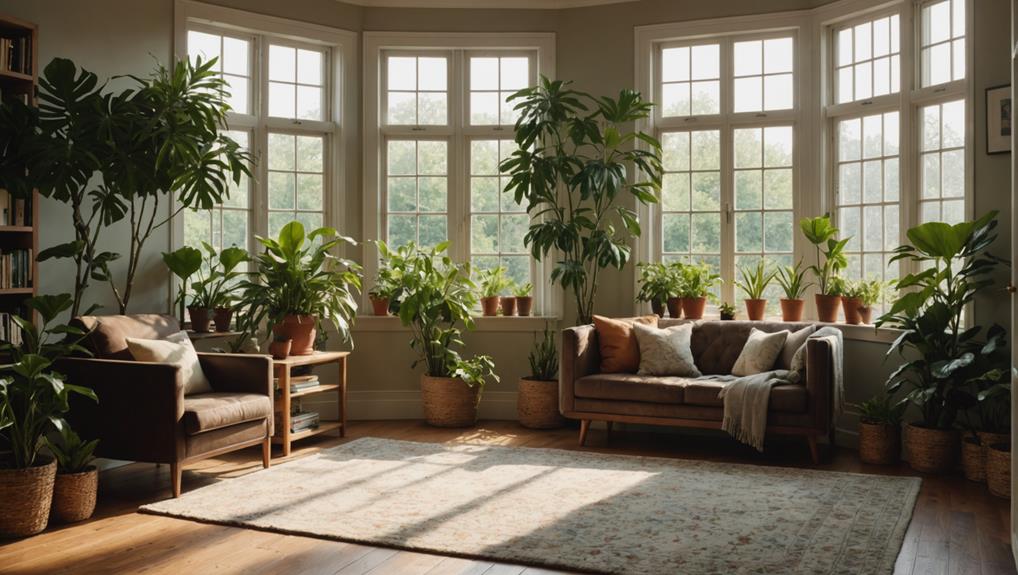Bay windows are attractive features that enhance a home's aesthetic appeal and functionality. They increase natural light and provide additional interior space for seating or displays. However, installation costs are higher than traditional windows, and they may lead to excessive heat gain or glare, resulting in increased cooling expenses. Homeowners might explore alternatives like three-lite slider, casement, or picture windows, which can offer similar benefits with potentially greater energy efficiency and lower costs. Understanding these elements is crucial for making informed choices about your home improvement projects. More insights can help clarify the best options for your needs.
Key Takeaways
- Bay windows enhance aesthetic appeal and curb value while providing panoramic views and additional interior space for seating or displays.
- They increase natural light in living areas but may lead to higher cooling costs due to excessive sunlight.
- Installation costs for bay windows are generally higher compared to traditional window options, requiring careful budget consideration.
- Alternatives like three-lite slider, casement, and picture windows offer similar benefits with potentially better energy efficiency and lower costs.
Overview of Bay Windows
Bay windows are architectural features characterized by their protruding structure, which typically consists of three panels that extend outward, creating a unique space that enhances both the interior and exterior of a home.
This design allows for a panoramic view of the outside environment, bringing an element of openness to living spaces.
Bay windows can be constructed in various styles, including traditional, modern, and contemporary, making them versatile additions to different architectural designs.
They are often positioned in living rooms, dining areas, or bedrooms, serving as focal points that invite light and create a sense of depth.
The integration of bay windows can significantly influence the overall aesthetic appeal and functionality of a residence.
Benefits of Bay Windows
The unique design of bay windows offers a range of advantages that enhance both the functionality and aesthetic appeal of a home.
Firstly, they create additional interior space, providing opportunities for seating, workspaces, or decorative displays. This extra space contributes to a more inviting atmosphere.
Moreover, bay windows significantly increase natural light, brightening frequently used areas and reducing reliance on artificial lighting.
Their distinctive architectural style can enhance curb appeal, ultimately increasing property value, making them a sound investment.
Furthermore, bay windows offer versatile design options, allowing homeowners to express personal style through various furnishings and decorations.
Drawbacks of Bay Windows
While bay windows offer numerous benefits, they also come with several drawbacks that potential buyers should consider before installation.
The installation costs are significantly higher than traditional windows due to their complex design and requirements.
Additionally, the three-sided structure can lead to excessive sunlight and glare, increasing cooling costs during summer months.
Bay windows often necessitate custom-sized accessories, which can complicate maintenance and add to overall expenses.
Furthermore, while they provide warmth during winter, the increased heat gain may create discomfort in summer.
Alternatives to Bay Windows
Considering various window options can provide homeowners with effective alternatives to bay windows that still enhance natural light and aesthetic appeal.
Three-lite slider windows offer a sleek design with three panels that improve light and ventilation while maintaining a modern appearance.
Casement windows, with their hinged structure, allow for excellent airflow and unobstructed views, adding both beauty and value to the home.
Picture windows create expansive, uninterrupted views and can be strategically combined with operable windows for ventilation.
Additionally, these alternatives are often more cost-effective and may offer better energy efficiency, reducing overall heating and cooling expenses.
Choosing the Right Window Style
Assessing individual needs and preferences is crucial when selecting the most suitable window style for a home.
Consider functionality, aesthetics, and budget to ensure that the chosen windows enhance both the interior and exterior of the property.
Understanding the local climate is also important, as different designs can impact energy efficiency and thermal comfort.
Homeowners should weigh long-term investments against initial costs, considering how each window style may contribute to property value.
Consulting with professionals can provide valuable insights tailored to specific requirements.
Additionally, staying informed about current design trends can help homeowners make choices that reflect contemporary aesthetics while increasing curb appeal and marketability.
This holistic approach ensures a satisfying and effective window selection process.
Expert Insights on Bay Windows
Gaining expert insights on bay windows can significantly enhance a homeowner's understanding of their unique benefits and considerations when making a selection.
Professionals emphasize the importance of assessing the architectural style of the home, ensuring that bay windows complement the existing design.
Additionally, experts highlight the need to balance aesthetics with functionality; while bay windows provide ample natural light, considerations around excessive glare and heat gain are crucial.
Installation costs can be higher due to their complex structure, so consulting with specialists, like those at Hodges, is advisable for tailored solutions.
Furthermore, understanding local climate impacts on energy efficiency can guide homeowners in making informed choices about window types that best suit their needs.
Summary of Key Considerations
Homeowners should prioritize several essential factors when evaluating the suitability of bay windows for their properties.
Key considerations include installation costs, as bay windows often require a larger investment compared to traditional options.
Additionally, homeowners should assess the potential for excessive sunlight, which can lead to increased cooling costs and discomfort during warmer months.
Maintenance requirements should also be evaluated, as the unique structure of bay windows may call for more upkeep.
Furthermore, understanding local climate impacts on energy efficiency is crucial.
Conclusion
In conclusion, bay windows offer a unique blend of aesthetic appeal and functional benefits, enhancing natural light and interior space.
However, the associated installation costs and maintenance demands warrant careful consideration.
Exploring alternatives may yield options that align more closely with specific needs and budgets.
Ultimately, the choice of window style should be approached with a discerning eye, as the right decision can significantly impact both the ambiance and value of a residence, proving that one size does not fit all.


Leave a Reply